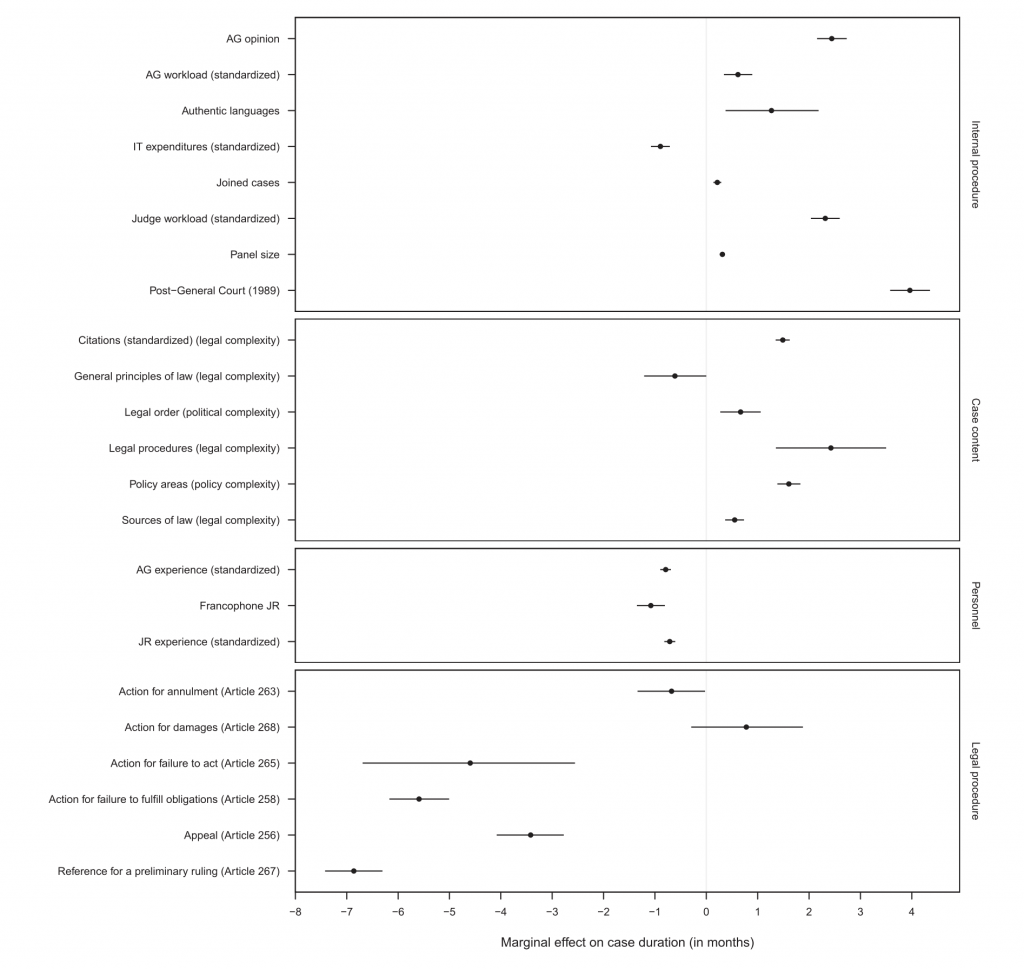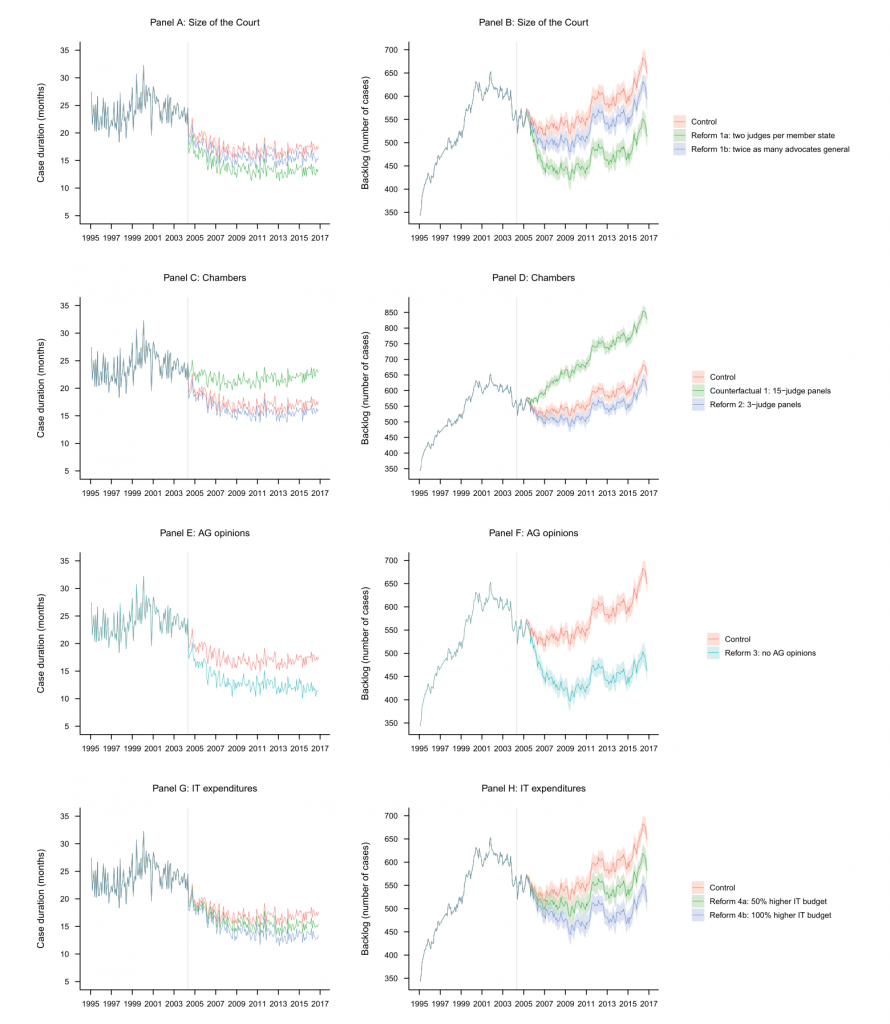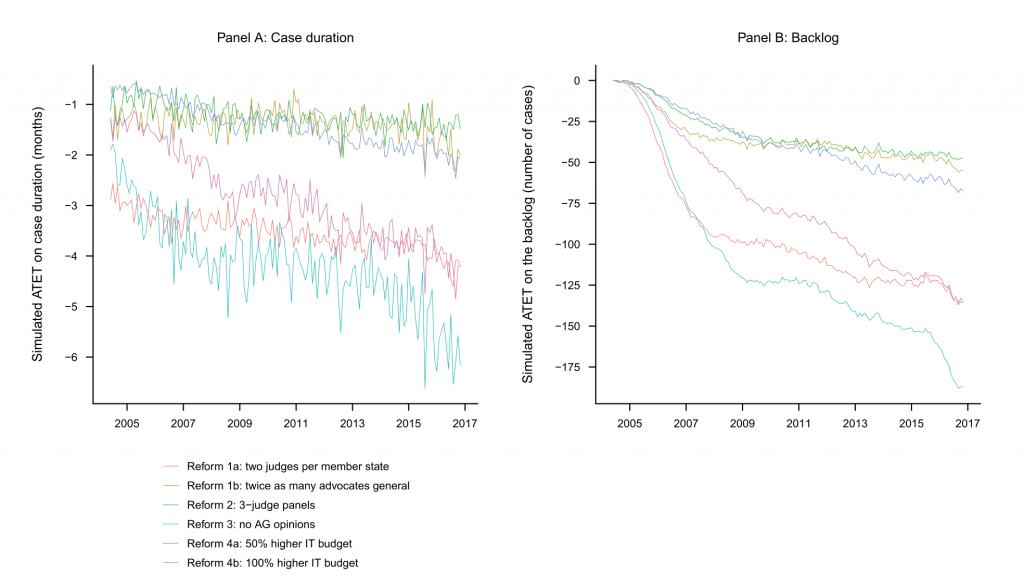The Court of Justice of the European Union currently has a huge backlog, with cases taking over 17 months on average to process. But how do the Court’s internal procedures affect the duration of cases? And how could the EU reform the Court to improve the timely administration of justice? Drawing on new research, Joshua Fjelstul, Matt Gabel and Cliff Carrubba evaluate potential institutional reforms to reduce the duration of cases and the size of the Court’s backlog.
The Court of Justice of the European Union (CJEU) is one of the most active and influential courts in the world. The Court of Justice – the highest court in the EU legal system – hears hundreds of cases a year. But the Court has an unsustainable backlog of over 600 cases, and the average case takes over 17 months to decide. Figure 1 shows these productivity metrics over time.
Figure 1: Case duration and the backlog at the Court of Justice
Note: This figure shows the average duration of Court of Justice cases (Panel A) and the backlog of Court of Justice cases (Panel B) by month from 1954 to 2018. The calculation includes a generalised additive model (GAM) smoother.
This delay in the administration of justice harms plaintiffs who are seeking relief from the Court. Former Presidents of the Court have expressed concern over how long it takes to decide cases, which could dissuade national courts from referring questions about EU law to the CJEU. That could undermine the uniform application of EU law.
In a new study, we estimate how characteristics of cases and the use of discretionary internal procedures affect case duration at the Court of Justice. Based on our findings, we identify a set of institutional reforms that we think would improve the Court’s productivity. We use computational simulations to evaluate the potential impact of those reforms. Here’s what you need to know about our findings and policy recommendations.
What factors affect case duration at the Court of Justice?
We estimate a statistical model using data on all Court of Justice cases (1954-2018) to identify factors that are associated with case duration (see Figure 2). We develop measures of the legal, political, and policy complexity of cases and find a strong association between case complexity and case duration.
Figure 2: Factors that affect case duration
Note: This figure shows the estimated marginal effect of each variable in a Bayesian regression model of case duration.
The Court doesn’t have docket control so there isn’t much it can do about what kind of cases it hears. But the Court does have discretion over the use of some internal procedures. First, the Court can decide not to request an Advocate General (AG) opinion. AGs are judge-like legal experts at the Court who often provide independent opinions on cases. We find that cases without AG opinions are 2.4 months shorter on average.
Second, the Court also has discretion over how many judges hear each case. The Court usually hears cases in panels of three or five judges. But it can also hear cases in a Grand Chamber, which can have 11 to 15 judges. A two-judge increase in the size of a panel (panels have to have an odd number of judges) is associated with a modest 0.62 month increase in case duration.
Personnel and budgetary resources also matter. A one standard-deviation increase in the average workload of judges (8 cases) is associated with a 2.3 month increase in case duration. A one million euro increase in the Court’s information technology (IT) budget, which goes toward case management systems, is associated with a 0.15 month decrease in case duration.
How could the EU reform the Court of Justice?
We identify four institutional reforms that we think would improve the Court’s productivity: doubling the number of judges from one per member state to two; exclusively using three-judge panels; eliminating AG opinions; and doubling the Court’s IT expenditures. We use computational simulations to assess the impact of each of these reforms on average case duration and the size of the backlog.
These are significant but realistic reforms. The EU doubled the number of judges at the General Court – the other Court that makes up the CJEU – between 2016 and 2021. The Court is already making an effort to use smaller panels and avoiding AG opinions in cases that don’t present novel legal questions. Increasing the Court’s IT expenditures is also feasible. Since 2018, total expenditures by the Court (440.6 million euros) have increased by 30.6 million euros, which is a larger increase than a 100% increase in IT expenditures (23.2 million in 2020).
We don’t know the characteristics of future cases, and can’t accurately forecast them, so we can’t use our model to predict the future impact of these reforms if they were implemented now. But we can simulate what the impact would have been if they had been implemented in the past using historical case data. We simulate these reforms as being implemented in 2004 – a turning point in the Court’s history.
Figure 3 shows simulated average case duration and the simulated backlog under each potential reform compared to a control. Figure 4 shows the expected impact of the reform over time (the vertical difference between the treatment and control lines in Figure 3). The more negative the value, the bigger the impact of the reform.
Figure 3: Results of the simulations
Note: This figure shows the simulated effect of each reform on average case duration (the left column) and on the size of the backlog (the right column) compared to a control.
Figure 4: Simulated impact of each reform
Note: This figure shows the simulated impact of each reform on average case duration (Panel A) and on the size of the backlog over time (Panel B). This is the vertical difference between the treatment and control lines in Figure 3.
Our simulations show that doubling the number of judges (Reform 1a), eliminating AG opinions (Reform 3), and doubling IT expenditures (Reform 4b) in 2004 would have each reduced average case duration by at least four months and the size of the Court’s backlog by over 125 cases by 2017.
Our policy recommendations
Our analysis indicates that increasing the number of judges, eliminating AG opinions, and increasing funding for case management systems could substantially reduce the average duration of cases. However, we also recognise that reforms aimed at efficiency could also have negative side effects on quality and consistency.
Eliminating AG opinions would have a big impact on the backlog, but AG opinions also play an important role in the judicial process by serving as a public signal of the merits of the case. AG opinions may deter the Court from making overly political rulings, so eliminating them could lead to a politicisation of the judicial process.
Using three-judge panels would lead to a limited improvement in efficiency, but reducing panel size could also have a negative side effect – when there’s variation in the preferences of judges, using smaller chambers will increase the variance of judicial outcomes, undermining the consistency of EU law.
With this in mind, we make two policy recommendations. First, the EU should increase the number of judges at the Court of Justice from one per member state to two per member state. Second, the Court should invest in better case management systems. We think these reforms – which are about increasing resources – are less likely than the other procedural reforms we evaluate to negatively impact the quality and consistency of judicial decision-making in the EU.
For more information, see the authors’ accompanying paper at the Journal of European Public Policy
Note: This article gives the views of the authors, not the position of EUROPP – European Politics and Policy or the London School of Economics. Featured image credit: Court of Justice of the European Union










Is there any analysis on 1/ what would happen if we increased the number of referendaires and 2/ does the level of specialisation of referendaires and judges impact times?